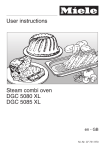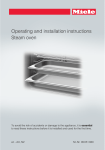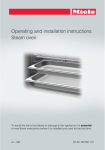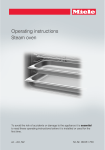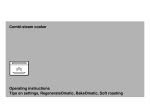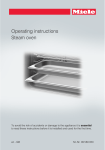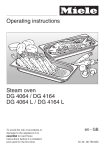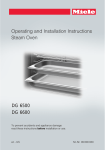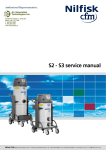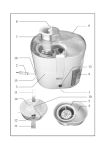Download Miele DG 5061
Transcript
User instructions Steam ovens en - AU, NZ M.-Nr. 07 217 800 Contents Foreword. . . . . . . . . . . . . . . . . . . . . . . . . . . . . . . . . . . . . . . . . . . . . . . . . . . . . . . . . 4 The advantages of cooking with steam . . . . . . . . . . . . . . . . . . . . . . . . . . . . . . . . . . 4 General notes . . . . . . . . . . . . . . . . . . . . . . . . . . . . . . . . . . . . . . . . . . . . . . . . . . . . . 4 Cooking containers. . . . . . . . . . . . . . . . . . . . . . . . . . . . . . . . . . . . . . . . . . . . . . . 4 Your own containers . . . . . . . . . . . . . . . . . . . . . . . . . . . . . . . . . . . . . . . . . . . . . . 5 Condensate tray . . . . . . . . . . . . . . . . . . . . . . . . . . . . . . . . . . . . . . . . . . . . . . . . . 5 Shelf levels . . . . . . . . . . . . . . . . . . . . . . . . . . . . . . . . . . . . . . . . . . . . . . . . . . . . . 5 Frozen food. . . . . . . . . . . . . . . . . . . . . . . . . . . . . . . . . . . . . . . . . . . . . . . . . . . . . 5 Temperature . . . . . . . . . . . . . . . . . . . . . . . . . . . . . . . . . . . . . . . . . . . . . . . . . . . . 6 Cooking duration (time) . . . . . . . . . . . . . . . . . . . . . . . . . . . . . . . . . . . . . . . . . . . 6 Cooking with liquid . . . . . . . . . . . . . . . . . . . . . . . . . . . . . . . . . . . . . . . . . . . . . . . 6 Your own recipes . . . . . . . . . . . . . . . . . . . . . . . . . . . . . . . . . . . . . . . . . . . . . . . . 6 Vegetables . . . . . . . . . . . . . . . . . . . . . . . . . . . . . . . . . . . . . . . . . . . . . . . . . . . . . . . 7 Meat . . . . . . . . . . . . . . . . . . . . . . . . . . . . . . . . . . . . . . . . . . . . . . . . . . . . . . . . . . . . 11 Fish . . . . . . . . . . . . . . . . . . . . . . . . . . . . . . . . . . . . . . . . . . . . . . . . . . . . . . . . . . . . 13 Other foods. . . . . . . . . . . . . . . . . . . . . . . . . . . . . . . . . . . . . . . . . . . . . . . . . . . . . . 16 Shellfish . . . . . . . . . . . . . . . . . . . . . . . . . . . . . . . . . . . . . . . . . . . . . . . . . . . . . . . . . 16 Mussels . . . . . . . . . . . . . . . . . . . . . . . . . . . . . . . . . . . . . . . . . . . . . . . . . . . . . . . . . 17 Rice . . . . . . . . . . . . . . . . . . . . . . . . . . . . . . . . . . . . . . . . . . . . . . . . . . . . . . . . . . . . 18 Pasta . . . . . . . . . . . . . . . . . . . . . . . . . . . . . . . . . . . . . . . . . . . . . . . . . . . . . . . . . . . 19 Dumplings . . . . . . . . . . . . . . . . . . . . . . . . . . . . . . . . . . . . . . . . . . . . . . . . . . . . . . . 20 Grains . . . . . . . . . . . . . . . . . . . . . . . . . . . . . . . . . . . . . . . . . . . . . . . . . . . . . . . . . . 21 Dried pulses. . . . . . . . . . . . . . . . . . . . . . . . . . . . . . . . . . . . . . . . . . . . . . . . . . . . . . 22 Hen's eggs . . . . . . . . . . . . . . . . . . . . . . . . . . . . . . . . . . . . . . . . . . . . . . . . . . . . . . 23 Fruit . . . . . . . . . . . . . . . . . . . . . . . . . . . . . . . . . . . . . . . . . . . . . . . . . . . . . . . . . . . . 24 Menu cooking . . . . . . . . . . . . . . . . . . . . . . . . . . . . . . . . . . . . . . . . . . . . . . . . . . . . 25 Defrosting . . . . . . . . . . . . . . . . . . . . . . . . . . . . . . . . . . . . . . . . . . . . . . . . . . . . . . . 27 Reheat . . . . . . . . . . . . . . . . . . . . . . . . . . . . . . . . . . . . . . . . . . . . . . . . . . . . . . . . . . 30 Bottling . . . . . . . . . . . . . . . . . . . . . . . . . . . . . . . . . . . . . . . . . . . . . . . . . . . . . . . . . 32 2 Contents Extracting juice with steam. . . . . . . . . . . . . . . . . . . . . . . . . . . . . . . . . . . . . . . . . 34 Special programmes . . . . . . . . . . . . . . . . . . . . . . . . . . . . . . . . . . . . . . . . . . . . . . 35 Preparing yoghurt . . . . . . . . . . . . . . . . . . . . . . . . . . . . . . . . . . . . . . . . . . . . . . . . . 35 Proving dough . . . . . . . . . . . . . . . . . . . . . . . . . . . . . . . . . . . . . . . . . . . . . . . . . . . . 36 Melting gelatine . . . . . . . . . . . . . . . . . . . . . . . . . . . . . . . . . . . . . . . . . . . . . . . . . . . 36 Melting chocolate . . . . . . . . . . . . . . . . . . . . . . . . . . . . . . . . . . . . . . . . . . . . . . . . . 37 Skinning vegetables and fruit . . . . . . . . . . . . . . . . . . . . . . . . . . . . . . . . . . . . . . . . 38 Apple storage . . . . . . . . . . . . . . . . . . . . . . . . . . . . . . . . . . . . . . . . . . . . . . . . . . . . 39 Blanching . . . . . . . . . . . . . . . . . . . . . . . . . . . . . . . . . . . . . . . . . . . . . . . . . . . . . . . . 39 Steaming onions . . . . . . . . . . . . . . . . . . . . . . . . . . . . . . . . . . . . . . . . . . . . . . . . . . 40 Bacon. . . . . . . . . . . . . . . . . . . . . . . . . . . . . . . . . . . . . . . . . . . . . . . . . . . . . . . . . . . 40 Disinfecting containers . . . . . . . . . . . . . . . . . . . . . . . . . . . . . . . . . . . . . . . . . . . . . 41 Heating flannels . . . . . . . . . . . . . . . . . . . . . . . . . . . . . . . . . . . . . . . . . . . . . . . . . . . 41 Decrystallising honey. . . . . . . . . . . . . . . . . . . . . . . . . . . . . . . . . . . . . . . . . . . . . . . 42 3 Foreword Please read through the operating instructions carefully to help you familiarise yourself with the appliance and also for information on how to use the different functions. The advantages of cooking with steam Almost all vitamins and minerals are retained as the food is not immersed in water. Cooking with steam also retains the true taste of the food better than conventional cooking. We therefore recommend seasoning the food after it has been cooked. Food retains its fresh, orginal colour. General notes This section contains general information about steam cooking. You will find more detailed information about particular foods and how to cook them in the other sections. Cooking containers This steam oven is supplied with stainless steel cooking containers. Other containers, in a variety of sizes, both perforated and solid, are available as optional extras (please refer to "Optional accessories" in the operating instructions supplied with the appliance). This enables you to choose the most suitable container for the food you are preparing. It is best to use perforated containers if possible. The steam can reach the food from all sides and the food is cooked evenly. 4 Foreword Your own containers You can also use your own containers. However, please note the following: – If using plastic cooking containers, make sure that they are heat-resistant to 100 °C and able to withstand hot steam. With plastic containers please check with the manufacturer that they are suitable for use in a steam oven. – Thick-sided containers made from porcelain, china or stoneware, for example, are not so suitable for steam cooking. They do not conduct heat well and as a result cooking durations will be considerably longer than those given in the charts. – Place the cooking containers on the rack and not on the oven floor. – Ensure that there is a gap of at least 3 cm between the upper rim of the container and the top of the cooking compartment to allow sufficient steam into the container. Condensate tray When you are using perforated containers, place the condensate tray on the floor of the appliance to collect any drops of liquid and allow them to be removed easily. Shelf levels You can select any shelf level. You can also cook on several levels at the same time. This will not alter the cooking duration. Frozen food Do not place more than 1.5 kg of frozen food in the appliance at a time. The greater the quantity of frozen food, the longer the heating up phase. 5 Foreword Temperature A maximum temperature of 100 °C is reached in the steam oven. Most types of food will cook at this temperature. Some more delicate types of food, such as soft fruit, must be cooked at lower temperatures as otherwise they will burst. More information is given in the relevant section. Cooking duration (time) In general, the cooking durations for cooking with steam are the same as for cooking food in a saucepan. More information about any factors which may affect the cooking duration is given in the relevant sections. The quantity of food does not affect the cooking duration. 1 kg of potatoes will take the same time to cook as 500 g. The durations given in the charts are guidelines only. We recommend selecting the shorter cooking duration quoted to start with. If food is not cooked sufficiently after the shorter time it can be put back in the oven and cooked some more. Cooking with liquid When cooking with liquid only fill the cooking container 2/3 full to prevent the liquid spilling when the cooking container is removed from the oven. Your own recipes Food and recipes which are prepared in pot or a pan can also be cooked in the steam oven. The cooking times in the steam oven will be the same. Please note that food will not be brown or crisp when cooking with steam. 6 Vegetables Fresh vegetables Prepare fresh vegetables in the usual way, i.e. wash, clean and cut them up. Frozen vegetables Frozen vegetables do not need to be defrosted before steaming unless they have been frozen together in a block. Frozen and fresh vegetables which take the same length of time to cook can be cooked together. If vegetables have frozen together in clumps, break these up before cooking with steam. Follow the manufacturer's instructions on the packaging regarding cooking duration. Cooking containers Food such as peas or asparagus spears, which have little or no space between them will take longer to cook because the steam has less space to work in. For an even result, it is best to use a shallow container for these types of foods, and only fill it 3-5 cm deep. When cooking large quantities divide the food between 2 or 3 shallow cooking containers rather than using one deep one. Different types of vegetables which take the same length of time to cook can be cooked together. Use solid containers for vegetables which are cooked in liquid such as cabbage. Shelf levels When cooking vegetables with a distinctive colour (e.g. beetroot) in a perforated container at the same time as cooking other foods in other containers, place the condensate tray directly underneath the container with the beetroot to catch any drips and so avoid any colour transfer. Temperature Vegetables are steamed at 100 °C. 7 Vegetables Cooking duration As with conventional methods, when cooking vegetables with steam the cooking duration will depend on the size and also whether you want the vegetables to be al dente or soft/well done. Example: waxy potatoes, cut into quarters = approx. 18 minutes waxy potatoes, cut in half = approx. 22 minutes Brussels sprouts, large, al dente = approx. 12 minutes Brussels sprouts, small, soft = approx. 12 minutes 8 Vegetables Settings The durations given in the chart are guidelines for fresh vegetables. We recommend selecting the shorter cooking duration quoted. If food is not cooked sufficiently after the shorter time it can be put back in the oven and cooked some more. Temperature in °C Duration in minutes Artichokes 100 35 - 40 Cauliflower, whole 100 20 - 45 Cauliflower florets 100 6 - 10 Green beans 100 8 - 12 Broccoli florets 100 4-8 Chicory 100 3-5 Chinese cabbage 100 4-6 Peas 100 3-8 Sugar snap peas 100 3-8 Fennel, halved 100 12 - 16 Fennel, cut into strips 100 6 - 10 Curly kale, chopped 100 20 - 30 Carrots, sliced 100 6 - 10 Potatoes, peeled and halved 100 20 - 40 Kohlrabi, cut into batons 100 6 - 10 Pumpkin, diced 100 3-6 Corn on the cob 100 10 - 25 Swiss chard 100 2-6 Peppers, cut into strips 100 2-6 New potatoes 100 25 - 40 9 Vegetables Temperature in °C Duration in minutes Leeks, sliced 100 4-8 Leeks, halved lengthwise 100 8 - 12 Romanesco, whole 100 15 - 30 Romanesco florets 100 6 - 10 Brussels sprouts 100 12 - 16 Beetroot, whole 100 40 - 50 Red cabbage, chopped 100 20 - 30 Black salsify, whole 1 cm thick 100 8 - 12 Celeriac, cut into batons 100 8 - 10 White asparagus 100 10 - 16 Green asparagus 100 7 - 12 Spinach 100 2-4 Spring cabbage, chopped 100 8 - 10 Celery stalks 100 7 - 10 Swede, batons/diced 100 7 - 12 White cabbage, chopped 100 15 - 20 Savoy cabbage, chopped 100 6 - 10 Courgettes, sliced 100 2-4 10 Meat Fresh meat Prepare the meat in the usual way. Frozen meat Meat should be thoroughly defrosted cooking in the steam oven (see "Defrosting"). Preparation For meat which needs to be seared before being cooked, e.g. stewing steak, sear the meat in a pan on the hob first. Then place it in the oven to cook it with steam. Cooking container Any. Shelf level Any. Temperature Meat is cooked in the steam oven at 100 °C. Cooking duration The cooking duration depends on the thickness and tenderness of the meat, and not on the weight. The thicker the food, the longer the cooking duration. A piece of meat weighing 500 g which is 10 cm thick will take longer to cook than a piece of meat weighing 500 g but which is 5 cm thick. Useful tips Use a perforated container to retain the flavours when cooking meat, such as prime beef topside. Place a solid container underneath to catch the juices. You can use these to make a gravy or freeze them for later use. 11 Meat Boiling fowl, pork rind, meat, ribs and meat bones can all be used to make delicious stock. Place the meat together with some mixed vegetables in a solid cooking container and add cold water. Cook at 100 °C for 60 to 90 minutes. The longer the cooking duration, the stronger the stock. Settings The durations given in the charts are guidelines only. We recommend selecting the shorter cooking duration quoted. If food is not cooked sufficiently after the shorter time it can be put back in the oven and cooked some more. 12 Temperature in °C Duration in minutes Flank 100 60 - 70 Knuckle 100 90 - 95 Chicken breast fillet 100 8 - 10 Veal cutlets 100 3-4 Gammon steaks 100 6-8 Lamb stew 100 12 - 16 Turkey roulade 100 12 - 15 Turkey escalopes 100 4-6 Poularde/Spring chicken 100 50 - 60 Beef stew 100 40 - 50 Boiling fowl 100 50 - 60 Prime beef topside 100 60 - 100 Fish Fresh fish Prepare fresh fish in the usual way, i.e. clean, gut and fillet. Frozen fish Defrost frozen fish (see "Defrosting"). Preparation Add some lemon or lime juice to fish before cooking. The citric acid helps the flesh stay firm. It is not necessary to season fish when cooking with steam as this method retains the minerals which give the fish its unique flavour. Cooking container Any. If using a perforated container, grease it first. Shelf level When cooking fish in a perforated container at the same time as cooking other types of food in other containers, place the condensate tray directly underneath the container with the fish to catch any liquid and so avoid any transfer of flavour to other food. Temperature 85 °C For gently cooking delicate types of fish, such as sole. 100 °C For cooking firmer types of fish, e.g. cod and salmon. Also for cooking fish in sauce or stock. 13 Fish Cooking duration The cooking duration depends on the thickness and the texture of the fish, and not on the weight. The thicker the fish, the longer the cooking duration. A 3 cm thick piece of fish weighing 500 g will take longer to cook than a 2 cm thick piece of fish weighing 500 g. The longer fish cooks, the firmer its flesh will become. Use the cooking durations given in the chart. If you find that the fish is not cooked sufficiently, only cook it for a few minutes more. When cooking fish in sauce or stock, we recommend that you increase the cooking duration quoted by a few minutes. Useful tips Adding herbs and spices, such as dill, will help bring out the full flavour of the fish. Cook large fish in the swimming position. To help maintain the structure of the fish, place a small cup or similar upside down in the cooking container, and arrange the fish belly side down over the cup. You can use any fish scraps, e.g. fish heads, bones, tails etc to make a fish stock. Place the fish scraps together with some mixed vegetables in a solid cooking container and add cold water. Cook at 100 °C for 60 to 90 minutes. The longer the cooking duration, the stronger the stock. Blue fish is fish which is cooked in water and vinegar. It is important not to damage the skin of the fish. This method is suitable for cooking carp, trout, tench, eel and salmon. 14 Fish Settings The cooking durations given in the chart are guidelines for fresh fish. We recommend selecting the shorter cooking duration quoted. If food is not cooked sufficiently after the shorter time it can be put back in the oven and cooked some more. Temperature in °C Duration in minutes Eel 100 5-7 Perch fillet 85 6-8 Seabream fillet 85 3-5 Coral cod, whole 85 15 - 20 Trout, 250 g 90 10 - 12 Shark steak 90 5-7 Halibut fillet 85 3-5 Atlantic cod fillet 100 4-6 Carp, 1.5 kg 100 18 - 25 Salmon fillet 100 4-8 Salmon trout 100 13 - 15 Pangasius fillet 85 3-5 Rose fish fillet 100 6-8 Haddock fillet 100 6-8 Plaice fillet 85 5-7 Monk fish fillet 85 8 - 10 Sole fillet 85 2-3 Turbot fillet 85 3-5 Tuna steak 100 3-5 Nile perch fillet 100 4-8 Pikeperch fillet 85 5-7 15 Other foods Shellfish Preparation Defrost frozen shellfish before cooking with steam. Peel, remove and discard the intestines, and then wash the shellfish. Cooking container Any. If using a perforated container, grease it first. Cooking duration The longer shellfish are cooked, the tougher they become. Follow the cooking durations given in the chart. When cooking shellfish in sauce or stock, we recommend that you increase the cooking duration quoted by a few minutes. Settings 16 Temperature in °C Duration in minutes Crevettes 90 3 Prawns 90 3 King Prawns 90 4 Small shrimps 90 3 Crayfish tails 95 10 - 15 Large shrimps 90 3 Other foods Mussels Fresh mussels ,Only cook mussels which are closed. N.B. Do not eat mussels which have not opened after being cooked. Danger of food poisoning. Steep fresh mussels in water for a few hours before cooking to rinse out any sand. Then scrub them thoroughly to clean them. Frozen muscles Defrost frozen mussels before cooking. Cooking duration The longer mussels are cooked, the tougher they become. Follow the cooking durations given in the chart. Settings Temperature in °C Duration in minutes Barnacles 100 2 Cockles 100 2 Bearded mussels 100 12 Pilgrim scallops 90 5 Razor clams 100 2-4 Venus mussels 100 4 17 Other foods Rice Rice swells when cooked and needs to be cooked in liquid. The proportion of rice to liquid will vary depending on the type of rice. The rice absorbs all the liquid and so none of the nutrients are lost. Settings Ratio Rice : Liquid Temperature in °C Duration in minutes Basmati rice 1:1 100 15 Parboiled rice 1:1 100 20 Round grain rice 1:2 100 25 1 : 1.5 100 35 - 40 1:1 100 35 - 40 Brown rice Wild rice 18 Other foods Pasta Dry pasta Dry pasta swells when it is cooked and needs to be cooked in liquid. The liquid must cover the pasta. Using hot liquid gives better results. Settings for dry pasta Reduce the cooking time recommended on the packaging by about 1/3 as the pasta will start to swell during the heating up time. Fresh pasta Fresh pasta, such as you can buy from the supermarket chilled counter, does not need to absorb water. Cook fresh pasta in a perforated container. Separate any pieces of pasta which have stuck together and spread them out in the cooking container. Settings for fresh pasta Temperature in °C Duration in minutes Gnocchi 100 2 Ravioli 100 2 Tortellini 100 2 19 Other foods Dumplings Ready made boil-in-the-bag dumplings need to be well covered with water as otherwise they can fall apart. This is because even although they have been soaked in water beforehand they will not absorb enough moisture. Cook fresh dumplings in a greased, perforated container. Settings 20 Temperature in °C Duration in minutes Yeast dumplings 100 12 - 15 Boil-in-the-bag potato dumplings 100 15 - 18 Boil-in-the-bag bread dumplings 100 15 - 18 Other foods Grains Grain swells during cooking and needs to be cooked in liquid. The proportion of grain to liquid will vary depending on the type of grain. Grain can be cooked whole or cracked. Settings Ratio Grain : Liquid Temperature in Duration in °C minutes Amaranth 1:2 100 40 Bulgur 1:1 100 10 Green spelt, cracked 1:1 100 10 Green spelt, whole 1:1 100 16 - 18 Oats, whole 1:1 100 16 - 18 Oats, cracked 1:1 100 10 Millet, whole 1:1 100 30 - 35 Polenta 1:3 100 10 Quinoa 1:2 100 10 Rye, whole 1:1 100 30 - 35 Rye, cracked 1:1 100 10 Wheat, whole 1:1 100 20 - 25 Wheat, cracked 1:1 100 10 21 Other foods Dried pulses Pulses swell during cooking and need to be cooked in liquid. The ratio of pulses to liquid should be 1:3. Soak pulses for at least 10 hours in cold water before cooking. Soaking makes pulses more digestible and shortens the cooking duration required. Exception: Lentils do not need to be soaked before cooking. Settings Temperature Duration in minutes in °C Pre-soaked Not pre-soaked Borlotti beans 100 55 110 Kidney beans 100 55 110 Black beans 100 60 120 Pinto beans 100 60 120 Haricot beans 100 25 - 30 60 Brown lentils 100 - 15 - 20 Red lentils 100 - 8 Yellow split peas 100 20 - 40 40 - 80 Green peas, shelled 100 20 - 25 40 - 80 Beans Lentils Peas 22 Other foods Hen's eggs Use a perforated container to prepare boiled eggs in the steam oven. The eggs do not need to be pierced before cooking as they are gradually warmed during the heating up phase and so do not burst when they are cooked with steam. Plunge the eggs into cold water after cooking to stop them from continuing to cook. When using a solid container for preparing egg dishes, remember to grease it first. Settings Temperature in °C Duration in minutes Eggs medium size, soft boiled 100 3-4 Eggs medium size, medium boiled 100 5-6 Eggs medium size, hard boiled 100 8 - 10 23 Other foods Fruit Cook delicate types of fruit, the skin of which burst easily (e.g. apricots), at 90 °C only. Cook fruit in a solid container so that none of the juice is lost. If you wish to cook fruit in a perforated container, place a solid container directly underneath it to collect the juice. Tip You can use the juice which has collected in the solid container to make a glaze for a fruit flan. Settings 24 Temperature in °C Duration in minutes Apricot halves 90 2-4 Apple pieces 100 3-5 Pear chunks 100 3-5 Cherries 90 2-4 Plums 100 2-4 Rhubarb 100 1-3 Sour cherries 90 2-4 Gooseberries 90 2-4 Menu cooking You can use the steam oven to cook a whole meal containing foods which have different cooking durations, e.g. fish fillet with rice and broccoli. The food which has the longest cooking duration is placed in the steam oven first and then each subsequent dish is placed in the oven at the appropriate time so that the whole meal is ready at the same time. Shelf level When cooking fish or food with a distinctive colour (e.g. beetroot) in a perforated container, place the condensate tray directly underneath the container to avoid any transfer of flavour or colour to other food. Temperature Whole meals should be cooked at a temperature of 100 °C as this is the temperature required to cook the majority of foods. Do not cook a whole meal at the lowest temperature when different temperatures are required for different types of food, e.g. 85 °C for seabream and 100 °C for potatoes. If the recommended cooking temperature for the food is 85 °C for example, try cooking it at 100 °C and testing the result. Some delicate types of fish with a soft structure, e.g. sole and plaice will become very firm when cooked at 100 °C. Cooking duration If you are increasing the recommended temperature, shorten the cooking duration by approx. 1/3. 25 Menu cooking Example Rice Fish fillet Broccoli 20 minutes 6 minutes 4 minutes 20 minutes - 6 minutes = 14 minutes (1st cooking duration: rice) 6 minutes - 4 minutes = 2 minutes (2nd cooking duration: fish fillet) Remaining time = 4 minutes (3rd cooking duration: broccoli) Duration 20 min - rice 6 min - fish fillet 4 min broccoli Setting 14 min 2 min ^ Place the rice in the oven first. ^ Set the first cooking duration: 14 minutes. ^ After 14 minutes, place the fish in the oven. ^ Set the second cooking duration: 2 minutes. ^ After 2 minutes, place the broccoli in the oven. ^ Set the third cooking duration: 4 minutes. 26 4 min Defrosting It is much quicker to defrost items in the steam oven than at room temperature. Temperature 60 °C is the best temperature for defrosting. Exceptions: 50 °C for minced meat and game, 100 °C for bread and cakes. Before and after defrosting Remove all packaging before defrosting. Exceptions: Leave bread, biscuits and cakes in their packaging as otherwise they will absorb moisture and become soft. Allow defrosted food to stand at room temperature after removing it from the oven. The standing time is necessary to allow the warmth to reach the core of the food from the outside. Cooking container/rack Use the rack with the condensate tray underneath it when defrosting food which will drip, such as poultry. This way food will not be lying in defrosted liquid. ,It is particulary important to observe food hygiene rules when defrosting poultry. Do not use the liquid from defrosted poultry. Pour it away and wash the tray, the sink and your hands. Danger of salmonella poisoning. Food which does not drip can be placed on the rack, in a cooking container or in a dish. Useful tips Fish does not need to be fully defrosted before cooking. Defrost so that the surface is sufficiently thawed to take herbs and seasoning. Depending on the thickness of the fish, 2 - 5 minutes should be enough. When defrosting food which has frozen together, e.g. berries, chops, fish fillets etc. separate it about half-way through the defrosting time. Do not refreeze food once it has thawed. Defrost frozen pre-cooked meals according to the manufacturer's instructions. 27 Defrosting Food to be defrosted Weight in g Temperature in °C Defrosting duration in minutes Standing time in minutes Cheese slices 125 60 15 10 Quark 250 60 20 - 25 10 - 15 Cream 250 60 20 - 25 10 - 15 Soft cheese 100 60 15 10 - 15 Apple sauce 250 60 20 - 25 10 - 15 Apple pieces 250 60 20 - 25 10 - 15 Apricots 500 60 25 - 28 15 - 20 Strawberries 300 60 8 - 10 10 - 12 Raspberries/ Blackcurrants 300 60 8 10 - 12 Cherries 150 60 15 10 - 15 Peaches 500 60 25 - 28 15 - 20 Plums 250 60 20 - 25 10 - 15 Gooseberries 250 60 20 - 22 10 - 15 300 60 20 - 25 10 - 15 Trout 500 60 15 - 18 10 - 15 Lobster 300 60 25 - 30 10 - 15 Small shrimps 300 60 4-6 5 Dairy products Fruit Vegetables Frozen in a block Fish 28 Defrosting Food to be defrosted Weight in g Temperature Defrosting in °C duration in minutes Standing time in minutes Meat Meat slices - 60 8 - 10 15 - 20 Minced meat 250 50 15 - 20 10 - 15 Minced meat 500 50 20 - 30 10 - 15 Goulash 500 60 30 - 40 10 - 15 Goulash 1000 60 50 - 60 10 - 15 Liver 250 60 20 - 25 10 - 15 Saddle of hare 500 50 30 - 40 15 - 15 Roebuck saddle 1000 50 40 - 50 10 - 15 Cutlets / chops / sausages 800 60 25 - 35 15 - 20 Chicken 1000 60 40 15 - 20 Chicken thighs 150 60 20 - 25 10 - 15 Chicken escalopes 500 60 25 - 30 10 - 15 Turkey drumsticks 500 60 40 - 45 10 - 15 60 10 - 12 10 - 15 60 15 10 - 15 100 6-7 1-2 Poultry Baked goods Puff pastries/ yeast buns Cakes/biscuits 400 Bread/rolls Bread rolls Rye bread, sliced 250 100 15 15 Wholegrain bread, sliced 250 100 15 - 20 10 - 15 White bread, sliced 150 100 10 - 15 10 - 15 29 Reheat The steam oven is very effective at reheating food gently, without drying it out or cooking it further. The food will reheat evenly and does not need to be stirred during the reheating process. You can reheat individual dishes or plated meals which have been prepared previously (e.g. meat, vegetables and potatoes). Suitable containers Small quantities can be reheated on a plate, larger quantities should be placed in a cooking container. Duration The number of plates or containers has no bearing on the cooking duration. The cooking durations listed in the chart relate to an average portion per plate/container. Increase the cooking duration for larger quantities. Useful tips Compact items, such as stuffed peppers or roulades, should be cut in half. 30 Reheat Procedure ^ Cover the food with a deep plate, a lid, or with clingfilm that is resistant to temperatures up to 100 °C and to steam. ^ Then place the plate on the rack in the oven. Settings Temperature in °C Duration in minutes Frankfurters 90 2-4 Casserole 100 5-6 Meat 100 4-5 Pork sausages 90 7 - 10 Poultry 100 4-5 Vegetables 100 2-3 Soup 100 3-4 Plated meals 100 3-4 Veal sausages 90 5-7 31 Bottling Only use unblemished, fresh produce which is in good condition for bottling. Glass jars Use clean glass jars and accessories and check them for any defects. Glass jars with twist off lids or glass lids with a rubber seal are suitable. Make sure that all the glass jars are the same size so that bottling is carried out evenly. After you have filled the jars with the bottled produce, clean the glass rims with a clean cloth and hot water and then seal the jars. Fruit Sort fruit carefully, rinse it briefly but thoroughly and allow it to drain. Take great care when cleaning soft fruit as it is very delicate and squashes easily. Remove any peel, stalks, cores or stones. Cut up large fruit. For example, cut apples into slices. If you are bottling fruit with stones (e.g. plums, apricots) without removing the stones, pierce the fruit several times with a fork or wooden screwer as otherwise it will burst. Vegetables Rinse, clean and cut up vegetables. Green vegetables should be blanched before bottling to help them retain their colour (see "Blanching"). Fill volume Fill the glass jars with produce up to a maximum of 3 cm below the rim. Do not pack it down as this will damage the cell walls of the produce. Tap the jar gently onto a cloth to help distribute the contents evenly. Fill the jars with liquid. The produce must be completely covered. Use a sugar solution for fruit and a salt or vinegar solution for vegetables. 32 Bottling Useful tips Make use of residual heat by leaving the jars in the oven for 30 minutes after it has switched off. Then cover the jars with a cloth and allow to cool for approx. 24 hours. Procedure ^ Place the rack on the lowest shelf level. ^ Place the jars on the rack (all the same size). Ensure that they do not touch one another. Settings Produce Temperature in °C Duration in minutes* Apples 90 50 Apple sauce 90 65 Red/Blackcurrants 80 50 Gooseberries 80 55 Fruit with stones 85 55 Beans 100 120 Gherkins 90 55 Fruit Vegetables * The times quoted are for 1.0 litre jars. If using 0.5 litre jars reduce the duration by about 15 minutes. If using 0.25 litre jars reduce the duration by about 20 minutes. 33 Extracting juice with steam You can use the steam oven to extract juices from fruit, such as soft berries and cherries. It is best to use overripe fruit, as the riper the fruit the greater the quantity of juice produced. Very ripe fruit will also produce a more intense flavour. Preparation Sort and clean the fruit. Cut out any blemishes. Remove the stalks from grapes and morello cherries as these are bitter. The stalks do not need to be removed from strawberries, raspberries etc. Useful tips Try experimenting with mild and tart flavours, for example, mix apples with elderberries. Adding sugar will increase the quantity of juice produced and improve the flavour. Sprinkle the fruit with sugar and leave to absorb for a few hours before juicing. For sweet fruit add 100 - 150 g sugar, and for more tart fruit 150 - 200 g sugar per kilo of fruit. If you wish to bottle the juice rather than consume it straight away, pour it whilst hot into hot, sterilised bottles up to the rim, and then seal immediately with sterilised tops. Procedure ^ Put the prepared fruit (cleaned, washed, chopped etc.) into a perforated cooking container. ^ Place a solid container or the condensate tray underneath to catch the juice. Settings Temperature: 100 °C Duration: 40-70 minutes 34 Special programmes Preparing yoghurt To prepare yoghurt you will need 100 g fresh yoghurt (with live culture) an 1 litre of milk. The yoghurt and milk should have the same percentage fat. You can use either unchilled long-life milk or fresh milk. If using fresh milk it should first be heated up to 90 °C (do not boil it) and then left to cool. Procedure ^ Mix 100 g yoghurt with 1 litre of milk. ^ Pour the mixture into portion sized glass jars or special yoghurt jars. Seal the jars. ^ Place the sealed jars in a cooking container or on the rack. Ensure that they do not touch one another. Useful tips How well home prepared yoghurt sets will depend on the consistency of the yoghurt used to prepare it. Fresh milk will give a better set than long-life milk. The yoghurt will not achieve its maximum set until it has been thoroughly chilled. You can buy yoghurt jars from specialist cook shops. Settings Temperatur: 40 °C Duration: 5:00 hours 35 Special programmes Proving dough Procedure ^ Prepare the dough according to the recipe. ^ Place a covered bowl on the rack. Settings Temperature: 40 °C Duration: according to recipe Melting gelatine Procedure ^ Gelatine leaves: Completely cover the gelatine leaves with cold water and leave to soak for 5 minutes. The gelatine leaves have to be fully covered with water. Remove the gelatine leaves from the bowl and squeeze them out. Empty the bowl. Place the squeezed gelatine leaves back in the bowl. ^ Gelatine powder: Place the gelatine powder in a bowl and add water according to the instructions on the packaging. ^ Cover the bowl and place on the rack. Settings Temperature: 90 °C Duration: 1 minute 36 Special programmes Melting chocolate You can use the steam oven for melting any type of chocolate. Procedure ^ Break the chocolate into small pieces. ^ Place large quantities in a solid container and small quantites in a cup or a dish. ^ Cover the container or the dish with temperature (up to 100 °C) and hot steam resistant clingfilm or a lid. ^ Stir large quantities once during cooking. Settings Temperature: 90 °C Duration: 10 minutes 37 Special programmes Skinning vegetables and fruit Procedure ^ Cut a cross in the top of tomatoes, nectarines etc. This will allow the skin to be removed more easily. ^ Place the fruit/vegetables in a perforated container. ^ To blanch almonds, it is important to plunge them into cold water as soon as they are taken out of the oven as otherwise the skin cannot be removed. Settings 38 Produce Temperature in °C Duration in minutes Apricots 100 1 Almonds 100 1 Nectarines 100 1 Capsicum 100 4 Peaches 100 1 Tomatoes 100 2 Special programmes Apple storage You can treat homegrown apples in the steam oven to increase the length of time you can store them for. Once treated, the apples will keep for 5 to 6 months when stored in a dry, cool and well-ventilated place. This method is only suitable for apples and not for other types of fruit. Settings Temperature: 50 °C Duration: 5 minutes Blanching Blanch fruit and vegetable before freezing them. Blanching helps maintain the quality of the produce when it is frozen. Blanching vegetables also helps them retain their original colour. Procedure ^ Put the prepared vegetables/fruit (cleaned, washed, chopped etc.) into a perforated cooking container. ^ Once blanched, plunge the vegetables/fruit into ice cold water to cool them down quickly. Drain them well. Settings Temperature: 100 °C Duration: 1 - 2 minutes 39 Special programmes Steaming onions Steaming means cooking the onions in their own juices, with the addition of a little fat if necessary. Procedure ^ Cut the onions up into small pieces and place them in a solid cooking container with a little butter. ^ Cover the container or the dish with temperature (up to 100 °C) and hot steam resistant clingfilm or a lid. Settings Temperature: 100 °C Duration: 4 minutes Bacon The bacon does not brown. Procedure ^ Place the bacon (diced or rashers) in a solid cooking container. ^ Cover the container with temperature (up to 100 °C) and hot steam resistant clingfilm or a lid. Settings Temperature: 100 °C Duration: 4 minutes 40 Special programmes Disinfecting containers The steam oven will disinfect baby bottles and other containers so that at the end of the programme they are as germ free as they would have been if boiled. Check beforehand that all parts, teats etc. are declared by the manufacturer to be heat resistant to 100 °C and also that they can withstand hot steam. All parts of the bottles must be completely dry before they are reassembled to keep them germ free. Procedure ^ Place the rack on the lowest shelf level. ^ Dismantle, clean and thoroughly rinse baby bottles. Place the individual parts on the rack, ensuring that they do not touch one another (on their sides or with the opening facing downwards) to allow hot steam to reach them from all sides. Settings Temperature: 100 °C Duration: 15 minutes Heating flannels Procedure ^ Moisten flannels and then roll them up. ^ Place them beside one another in a perforated cooking container. Settings Temperature: 70 °C Duration: 2 minutes 41 Special programmes Decrystallising honey Procedure ^ Loosen the lid and place the jar of honey in a perforated cooking container or on the rack. ^ Stir the honey once during the cooking procedure. Settings Temperature: 60 °C Duration: 90 minutes (depending on the size of jar or the amount of honey in the jar) 42 43 Alteration rights reserved / 1109 M.-Nr. 07 217 800 / 02












































